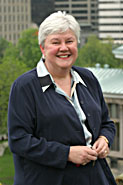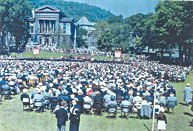Preparing for convocation
Kate Le Maistre describes her job as university marshal as "chef du protocol" for convocation. This year it might be better to describe her as the circus ringmaster. Not to worry -- clowns or elephants won't mar the pomp and circumstance of the event, but it will be held under the big top.

University Marshal Kate Le Maistre
Owen Egan
"This year we've actually built two theatres from the ground up. It's been a very different experience," said Le Maistre of the challenges of organizing 10 convocations, nine of them outdoors, under a massive tent on lower campus.
Convocation hasn't been held outdoors on campus since 1970. In recent years, the event has been held in the Fieldhouse, but, Le Maistre explained, it was felt by some that a gymnasium was an inappropriate location for such an important ceremony.
In addition, arts students had petitioned the Principal to have their faculty convocate together. The size of the Faculty of Arts had precluded this in years past.
"That's a very big faculty and there is no facility in Montreal that we can guarantee is big enough to hold them all. You could go to the Bell Centre, but it's pretty ugly. There isn't anywhere else that is appropriate for a faculty of that size," said Le Maistre.
The solution was to take it outside, but that created other problems. In years past McGill's convocation had been open air, but Le Maistre felt this was too risky.
"The secretary-general and I went to a couple of convocation ceremonies in the States to look at open air ceremonies, and we both got wet. Very, very wet," she said with a laugh.
The giant tent should solve that problem. It can hold roughly 5,000 people, and is open on the sides. It comes equipped with ceiling fans, and projection screens on either side will enhance the visibility of the stage.
"It's going to be spectacular. It's a beautiful tent -- it's a white canvas structure, and we're going to decorate it with flowers," said Le Maistre.
The decision to go to a tent meant making sacrifices in terms of capacity. Le Maistre explained that arts students have been limited to two tickets for family and friends to attend the convocation because of tight seating.

Convocation on lower field in 1952
McGill Archives
"The reason that's the number is that we're very restricted by the Montreal fire code. The size of the tent is determined by the two goalposts [on the field], which are set in concrete," she said. More people can watch the convocation live in Leacock 132, where the event will be simulcast.
"I don't know where the middle ground is on this one, but there will be more discussions on this next year."
As "chef du protocol," Le Maistre has a lot more on her plate. The education professor ("that's my day job," she jokes) has been spending more and more time on her marshalling duties as convocation approaches. This year is the last of her three-year term as marshal. In that time, she's recruited dozens of faculty marshals, shepherded even more honorary degree recipients on and off the stage and helped thousands upon thousands of students across the stage on their big day. Meanwhile, staff in secretariat handle all the finances, check and double check students' names and organize the nuts and bolts of the event.
"It should be a day that students and their families remember, and remember happily," she said, and that goal requires careful planning. Much of her job is like that of a theatre director. Her actors -- speakers, academics and students -- have to know their places, and their lines.
"Everyone has to know how to address the chancellor, for instance, and how to address the crowds... there's a lot of stage direction. In my three years here I've managed to convince people to talk about stage left and stage right," she said.
Even the order of who sits where on the stage is important. Honorary degree recipients all sit in the front, usually with their designated escort, often someone with whom they are already acquainted. Governors take precedence over senators, vice-principals over deans. Le Maistre explained that determining seating order gets pretty involved, as it did when a horde of university principals and rectors descended on McGill for the principal's installation.
"The oldest university has the best seat in the house, so to speak. So as people responded to their invitations, we checked the date of founding of their university, so the youngest processed first, and the oldest last."
On the day itself, Le Maistre and her volunteer faculty marshals will be acting as ushers of a sort. They make sure graduands are sitting in the right order, lining up properly and that their robes are on straight. They want to make sure there are no slip-ups -- literally.
"We have one person on the foot of the stairs, helping them up, one person at the head of the stairs to make sure things are moving at a reasonable pace toward the reader. There's someone at the other end of the stage helping them as they head off, because there are a lot of young ladies wearing heels that they don't normally wear. They're very excited, as they should be, and not really looking where they're going."
